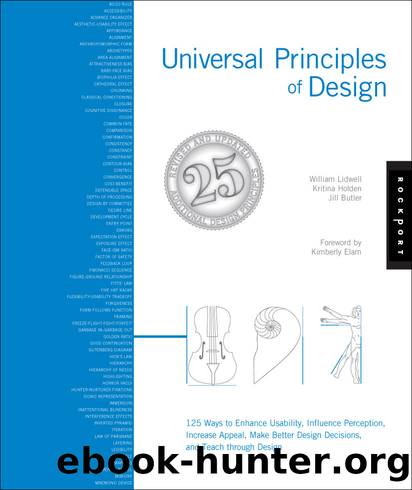Universal Principles of Design, Revised and Updated: 125 Ways to Enhance Usability, Influence Perception, Increase Appeal, Make Better Design Decisions, and Teach through Design by Butler Jill & Holden Kritina & Lidwell William

Author:Butler, Jill & Holden, Kritina & Lidwell, William [Butler, Jill]
Language: eng
Format: epub
Publisher: Creative Publishing International
Published: 2009-12-31T16:00:00+00:00
Law of Prägnanz
A tendency to interpret ambiguous images as simple and complete, versus complex and incomplete. 1
The Law of Prägnanz is one of several principles referred to as Gestalt principles of perception . It asserts that when people are presented with a set of ambiguous elements (elements that can be interpreted in different ways), they interpret the elements in the simplest way. Here, “simplest” refers to arrangements having fewer rather than more elements, having symmetrical rather than asymmetrical compositions, and generally observing the other Gestalt principles of perception. 2
For example, a set of shapes that touches at their edges could be interpreted as either adjacent or overlapping. When the shapes are complex, the simplest interpretation is that they are adjacent like pieces in a puzzle. When the shapes are simple, the simplest interpretation is that they overlap one another. The law applies similarly to the way in which images are recalled from memory. For example, people recall the positions of countries on maps as more aligned and symmetrical than they actually are.
The tendency to perceive and recall images as simply as possible indicates that cognitive resources are being applied to translate or encode images into simpler forms. This suggests that fewer cognitive resources may be needed if images are simpler at the outset. Research supports this idea and confirms that people are better able to visually process and remember simple figures than complex figures. 3
Therefore, minimize the number of elements in a design. Note that symmetrical compositions are perceived as simpler and more stable than asymmetrical compositions, but symmetrical compositions are also perceived to be less interesting. Favor symmetrical compositions when efficiency of use is the priority, and asymmetrical compositions when interestingness is the priority. Consider all of the Gestalt principles of perception (closure, common fate, figure-ground relationship, good continuation, proximity, similarity, and uniform connectedness).
See also Aesthetic-Usability Effect , Ockham’s Razor , Rule of Thirds , and Visuospacial Resonance .
Download
This site does not store any files on its server. We only index and link to content provided by other sites. Please contact the content providers to delete copyright contents if any and email us, we'll remove relevant links or contents immediately.
Wonder by R.J. Palacio(8224)
Unlabel: Selling You Without Selling Out by Marc Ecko(3450)
Ogilvy on Advertising by David Ogilvy(3289)
Hidden Persuasion: 33 psychological influence techniques in advertising by Marc Andrews & Matthijs van Leeuwen & Rick van Baaren(3267)
Drawing Cutting Edge Anatomy by Christopher Hart(3256)
Mastering Adobe Animate 2023 - Third Edition by Joseph Labrecque(3247)
POP by Steven Heller(3214)
The Pixar Touch by David A. Price(3182)
The Code Book by Simon Singh(2825)
The Art of War Visualized by Jessica Hagy(2814)
The Curated Closet by Anuschka Rees(2782)
Slugfest by Reed Tucker(2770)
Rapid Viz: A New Method for the Rapid Visualization of Ideas by Kurt Hanks & Larry Belliston(2700)
Stacked Decks by The Rotenberg Collection(2662)
The Wardrobe Wakeup by Lois Joy Johnson(2618)
365 Days of Wonder by R.J. Palacio(2602)
Keep Going by Austin Kleon(2568)
Tell Me More by Kelly Corrigan(2500)
Tattoo Art by Doralba Picerno(2466)
